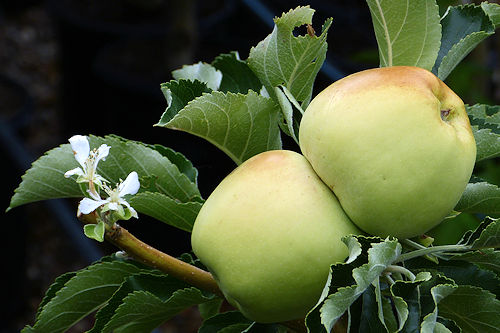Growing Apples:
Malus domestica
Back to Fruit, Berries and Nuts
Botanical Overview
A member of the Rose family (Rosaceae), the genus Malus contains 30-55 species of apples and crab apples from Asia, Europe, and North America. Apples are grown worldwide for their fruit and have more than 7500 cultivars.
Description
Form:
Tree.
Lifespan:
20-40 productive years.
Leaf retention:
Deciduous.
Growth rate:
Moderate.
Mature Size:
30-50' (9-15m) high and as wide without a grafted rootstock.
Flowers:
White, tinged with fading pink, five petals, in a cluster of 4-6 flowers.
Bloom:
Spring, at the same time as leaves develop. Blossoming lasts about 30 days.
Self-fruitful:
Some apple cultivars are self-fruitful, others require a different cultivar to provide pollen.
Years before fruiting:
One, but it takes 3-5 years for the number and quality of apples produced reach full
potential.
Fruit:
Round, white to pale yellow flesh, waxy skin of various colors.
Months for fruit to ripen:
2-7, depending on the cultivar.
Storage after harvest:
Depending on the cultivar, 2 weeks to 1 year in a refrigerator.
Leaves:
Yellow green to dark green, ovate to lanceolate shaped, finely toothed edges, lighter
underneath.
Stems:
Trunk bark reddish gray, thin, irregularly fissured.
Roots:
The tree is usually grafted onto a hardy rootstock. Rootstock varieties are chosen to control
the height of the tree from 1/3, 1/2, 2/3 to standard (full) size.
Cultivars of Note:
'Anna' Self-fruitful, greater production with
Einshemer or Golden Dorsett nearby, 200 chill hours.
'Einshemer' Self-fruitful, 100 chill hours.
'Ghost Apple' Self-fruitful, 300-400 chill hours,
white skin.
'Golden Dorsett' Self-fruitful, 100 chill hours.
Wildlife:
The flowers attract bees. The fruit attracts birds and mammals. Rabbits find the bark very
tasty and will chew it off, badly damaging or killing the tree. The bottom trunk of the tree
should be protected with a gnaw guard.
Toxic / Danger:
The seeds and leaves contain tiny amounts of hydrogen cyanide. The fruit is edible.
The seeds are toxic only if eaten in large quantities.
Origin:
The modern apple is a hybrid of several wild species found along ancient trade routes between
Asia minor and Central Asia.
Cultivation and Uses
USDA hardiness zones:
5-10 for cultivars which succeed in hot dry climates.
Chill hours:
For USDA zone 9 and above, select cultivars with a chill requirement of 300 hours or less and
high temperature tolerance.
Heat tolerant:
Depends on cultivar.
Drought tolerant:
Moderate.
Sun:
Full sun.
Planting:
Locate this tree in full sun in well draining soil. A low-lying area where cold air collects
might help with winter chill hour accumulation.
Soil:
Well draining, 3' (1m) deep or more, high organic content, slightly sandy, pH 6.1-7.5
(slightly acidic to neutral). Test the hole for drainage before you insert the plant.
Soil that remains wet can kill the tree from root rot. Plant on top of a 4' (1.2m) mound,
or a slope, to get proper drainage if necessary.
Fertilize:
Fertilize once a year in the early spring with an organic fertilizer.
Spread the fertilizer out to the drip line and 1' (0.3m) away from the trunk.
Water after becoming established:
Deep water or use two-ring basin irrigation every
one to two weeks, depending on temperature.
Mulch:
Spread organic mulch under the canopy and 8" (21cm) away from the trunk.
Prune:
In winter, remove dead, broken and diseased branches. Remove any branches growing down,
straight up, inward, or crossing other branches.
After fruit set, remove excess young apples when they are marble-sized so that only one remains every 6" (15cm) along a branch. This will prevent the tree from being over stressed and malnourished, and the apples from ripening too small.
After fruit set, remove excess young apples when they are marble-sized so that only one remains every 6" (15cm) along a branch. This will prevent the tree from being over stressed and malnourished, and the apples from ripening too small.
Litter:
Leaf and apple drop in the fall. Fallen apples should be removed quickly to prevent disease
and avoid attracting mammals.
Propagation:
Rooted cuttings, air layering, cuttings grafted onto rootstock. Seeds do not breed true.
Uses:
Ornamental, edible fruit.
Comments
Apples are easy to grow in hot, dry climates as long as a suitable cultivar is selected.Do you have additional information or a different experience for these plants that you would like to share? Email info@GardenOracle.com. All contributions are welcome and appreciated.



Latest update: August, 2024
© 2008-2025 by GardenOracle.com

